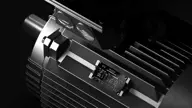
Understanding the differences: IE1, IE2, IE3, and IE4 motors
Electric motors are categorised into efficiency classes: IE1, IE2, IE3, and IE4, each representing a step up in energy efficiency. IE1 motors are the least efficient, while IE4 motors are the most efficient.
The primary differences among these classes lie in their energy consumption and operational efficiency, with each subsequent class offering improvements in these areas.
The four types of IE-motors
The International Electrotechnical Commission (IEC) has defined several classes of motor efficiency, known as IE (International Efficiency) ratings. These ratings help in distinguishing the energy efficiency of electric motors.
IE1 - Standard Efficiency: Often referred to as the first generation of energy-efficient motors, IE1 motors are the basic level of efficiency. They are typically used in less demanding applications where energy costs are not a primary concern.
- Output: 0.75kW to 355kW
- Poles: 2, 4, 6, 8, 10, 12
- Speed range: 500rpm to 3600 rpm
- Rpm frequency: 50Hz to 60 Hz
IE2 - High Efficiency: IE2 motors offer a significant step up in energy efficiency compared to IE1. They are well-suited for applications where motors run frequently, and energy savings can be realized over time.
- Output: 0.75kW to 355kW
- Poles: 2, 4, 6
- Speed range: 1000rpm to 3600 rpm
- Rpm frequency: 50Hz to 60 Hz
IE3 - Premium Efficiency: These motors are even more efficient than IE2 and are often mandated by regulations in various countries for their energy-saving capabilities. IE3 motors are ideal for continuous or near-continuous operations, offering substantial energy savings.
- Output: 0.75kW to 355kW
- Poles: 2, 4, 6, 8
- Speed range: 750rpm to 3600 rpm
- Rpm frequency: 50Hz to 60 Hz
IE4 - Super Premium Efficiency: The highest efficiency class currently, IE4 motors provide the greatest energy savings. They are designed for applications where motors run almost continuously, and high energy costs necessitate the best possible efficiency.
- Output: 2.2kW to 230kW
- Poles: 2, 4, 6, 8
- Speed range: 750rpm to 3600 rpm
- Rpm frequency: 50Hz to 60 Hz
Each step up in IE class represents a leap in energy efficiency, reducing operational costs and environmental impact. Hoyer Motors offers a range of motors across these classes, allowing customers to choose the most appropriate efficiency level for their specific application needs.
What are the differences between IE3 and IE4 motors?
IE3 and IE4 motors differ primarily in their energy efficiency.
IE4 motors, classified as 'Super Premium Efficiency', consume less energy and have lower operational costs compared to IE3, which are 'Premium Efficiency' motors. The efficiency in IE4 is achieved through advanced design, such as improved rotor and stator designs, and the use of higher quality materials.
Both motors use IC411 and IC416 cooling technology.
IE3 motors can have an aluminium frame size of 80-160 or a cast iron frame size of 80-400 while IE4 aluminium frames range from 100-160 and cast iron frames from 100-315.
Both motors are often integrated with Variable Frequency Drives and converters (VFDs) for improved control and efficiency in variable load applications.
While both are suitable for various industrial applications, IE4 motors are often chosen for applications where energy costs are a significant concern and for their longer-term sustainability benefits.
What are the differences between IE2 and IE3 motors?
IE2 motors, classified as high efficiency, have an output range similar to IE3, from 0.75kW to 355kW. However, they are limited to 2, 4, and 6 poles. IE2 motors, known as 'High Efficiency', offer a moderate level of energy efficiency, while IE3 motors provide a higher level of efficiency, termed 'Premium Efficiency'.
This improvement in IE3 motors is due to enhanced motor design and better-quality materials, which reduce energy loss during operation.
IE3 motors are often preferred in applications where energy savings and environmental impact are significant considerations.
What are the differences between IE1 and IE2 motors?
IE1 and IE2 motors differ in their energy efficiency, with IE2 motors being more efficient. IE1 motors, often referred to as 'Standard Efficiency', are the least efficient and are gradually being phased out in many regions due to their higher energy consumption.
However, standard efficiency IE1 motors are still used in applications where motor usage is infrequent or for shorter durations.
IE2 motors, on the other hand, offer better energy efficiency due to improvements in design and materials such as better-quality laminations in the stator and rotor, making them a more cost-effective and environmentally friendly option.
